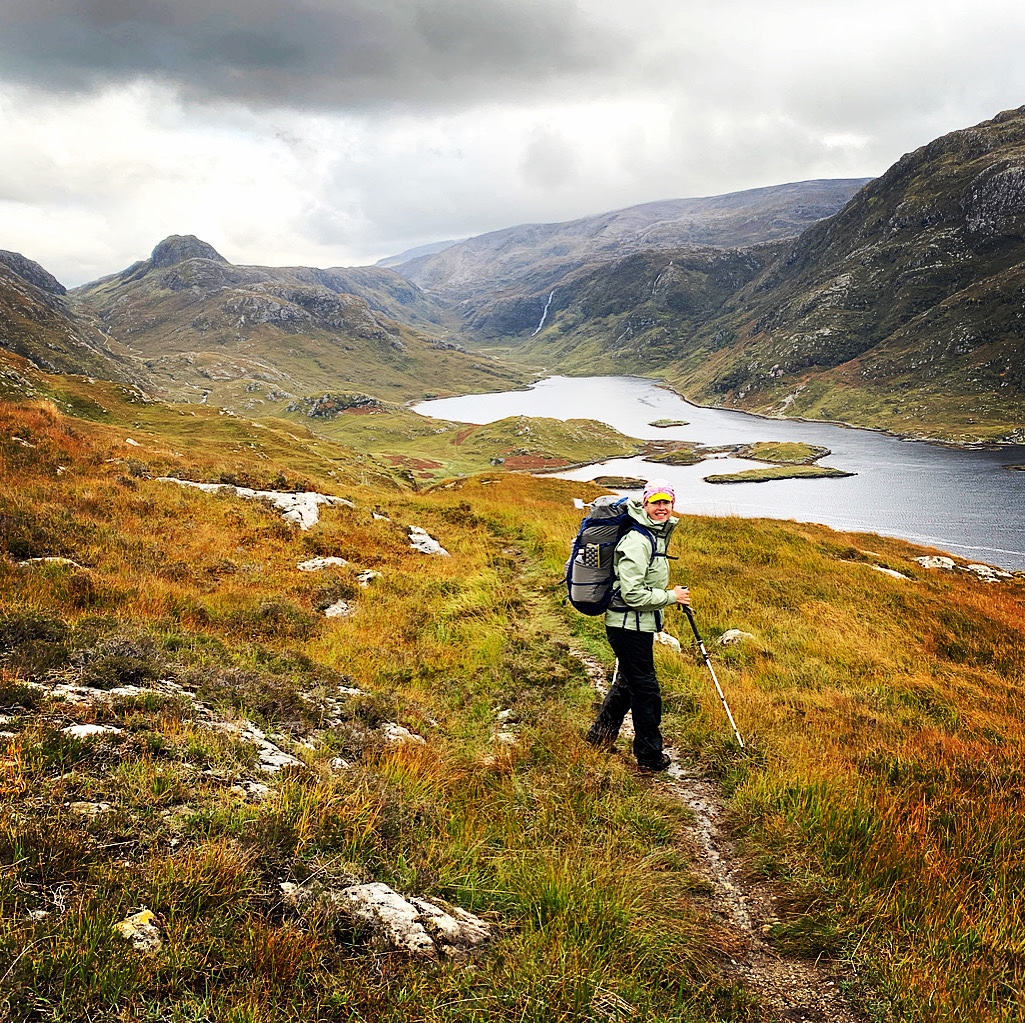
The day begins again with poached haddock and egg for breakfast, plus clear skies with a long pink streak signaling the sun rising somewhere beyond the crags. The birds in my beautiful oak of the orange and yellow leaves are singing happily.
It’s a stunning drive past massive mountains. Scotland was created by ancient volcanos and the separating of land masses. One behemoth reaches straight up like a hat, 90-degree angles on all sides. My favorite light appears, yellow with black in the distance.
We pass the ruins of a castle at the head of the loch, forlornly looking out to sea. The road is wild and curvy, the day (finally) spectacular. A bridge signals our turn, but we never seem to locate a town. Ted leaves his car where as far away from the ‘no overnight parking’ sign as possible.
It seems we’ve entered an estate of some sort. The gate is equipped with cameras, but open for walkers. We walk on tarmac at first, past large homes and rows of Land Rovers and Mercedes. Soon it’s a track and I need to put on my sunglasses, all done with much fanfare since it’s the first time they’ve been worn.
It’s easy walking, barely a puddle to navigate. This fjord or ‘arm-of-the-sea’ is called Glenhue. In it are long lines of black buoys holding up a kind of below surface lattice work for mussel farming. A boat is nearby at work and I think back to my first night in Scotland when I ate an entire pot of mussels and washed it down with whisky.
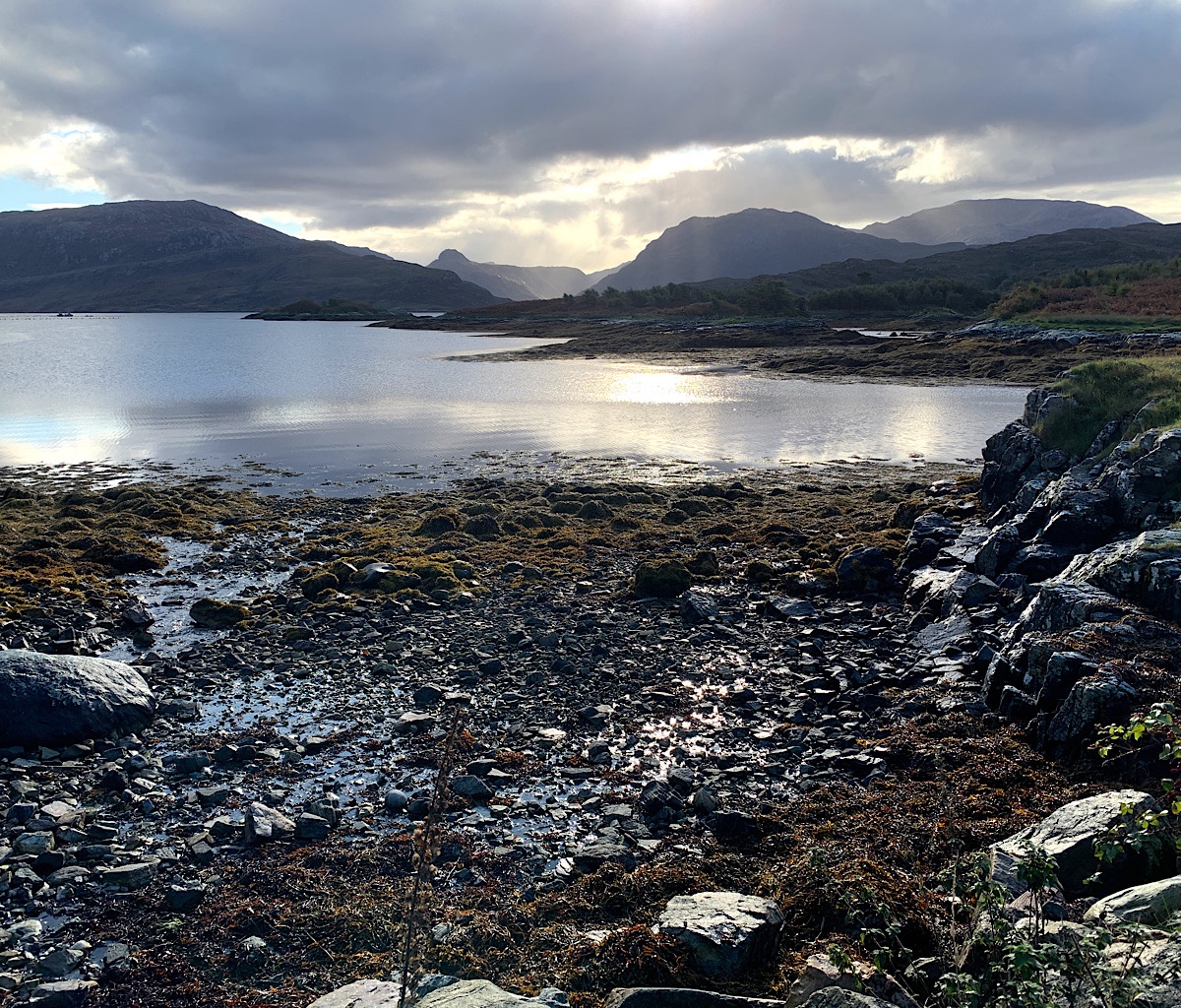
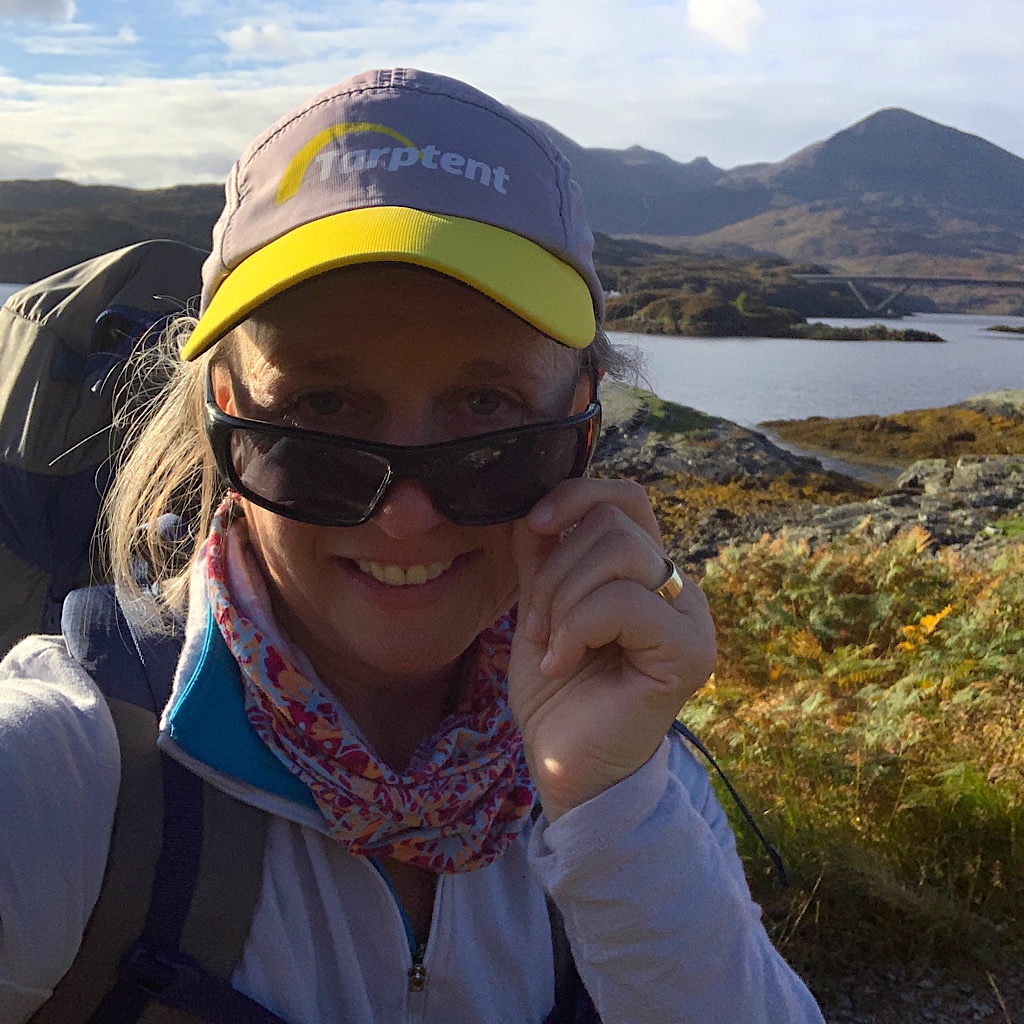
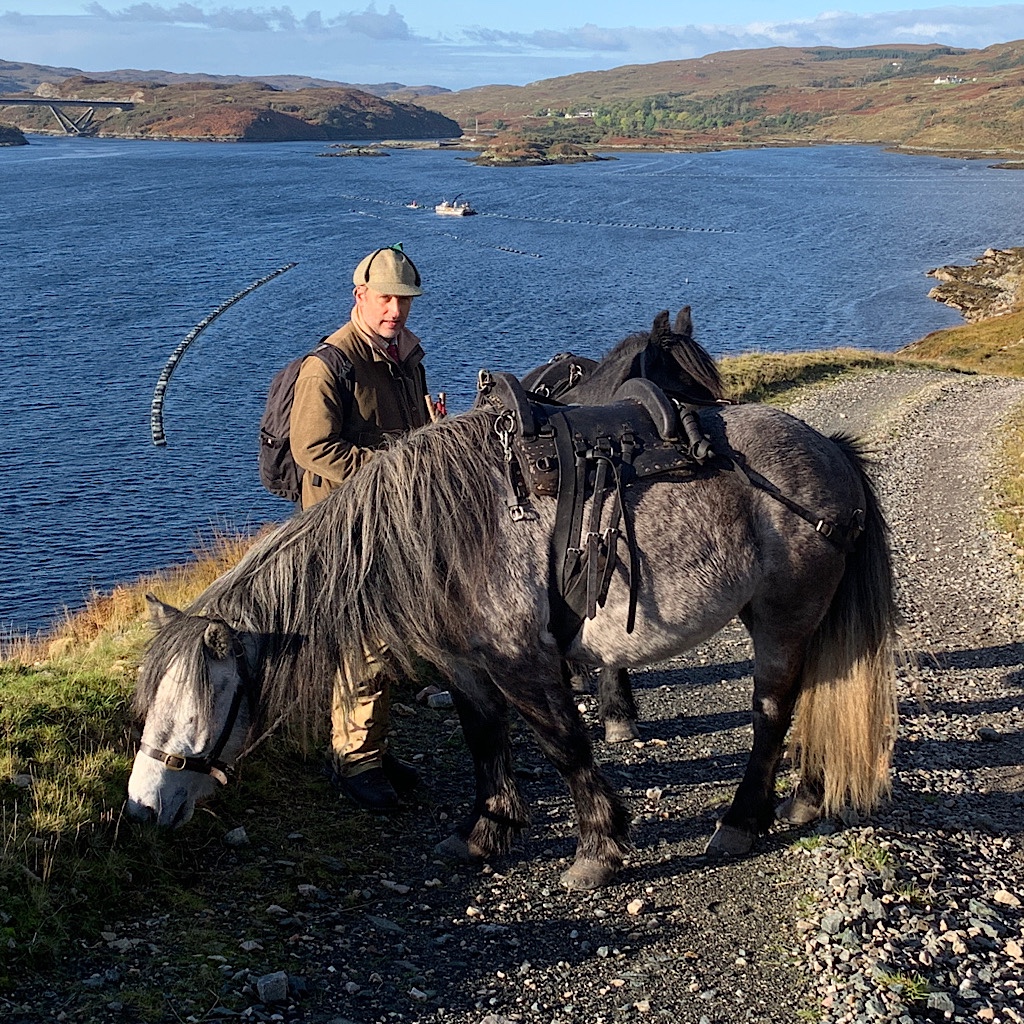
The track is not flat along the loch, but rolling up and down, waterfalls crashing down and racing to empty out at the seaweed-covered rocky shoreline. We plod along, passing a stalker dressed to the hilt and tending horses. A posh estate, and one we hope will keep its clients in luxury at the main house and not at the bothies.
There are two ahead – one along this track, and one reputed to be ‘hard underfoot’ getting there with indistinct track on a messy climb. I’m more worried the bothies will be off-limits in the middle of stalking season which runs until October 20.
Ted is sanguine on the subject, though insists we carry the tent in case we’re benighted with no place to stay. But where would one camp in all this damp?
Last night as we studied our route, he stumbled upon a blog which complained about a washed out footbridge. That caused a bit of panic until I assured him we would not cross anything dangerous and leave plenty of time to turn back if need be.
For now, we’re walking on superbly maintained track, a rock wall carefully constructed for safety as we seem to hang against the mountainside. I figure with this level of care, any washed out bridge has surely been replaced.
We make good time walking on the soft grass between ruts, rounding a bend and seeing a beautifully placed set of buildings underneath rocky mountainside. I squint but can’t see any bridge over the swollen river feeding the loch. One step at a time and ‘cross that bridge when I get there,’ I tell myself with a laugh.
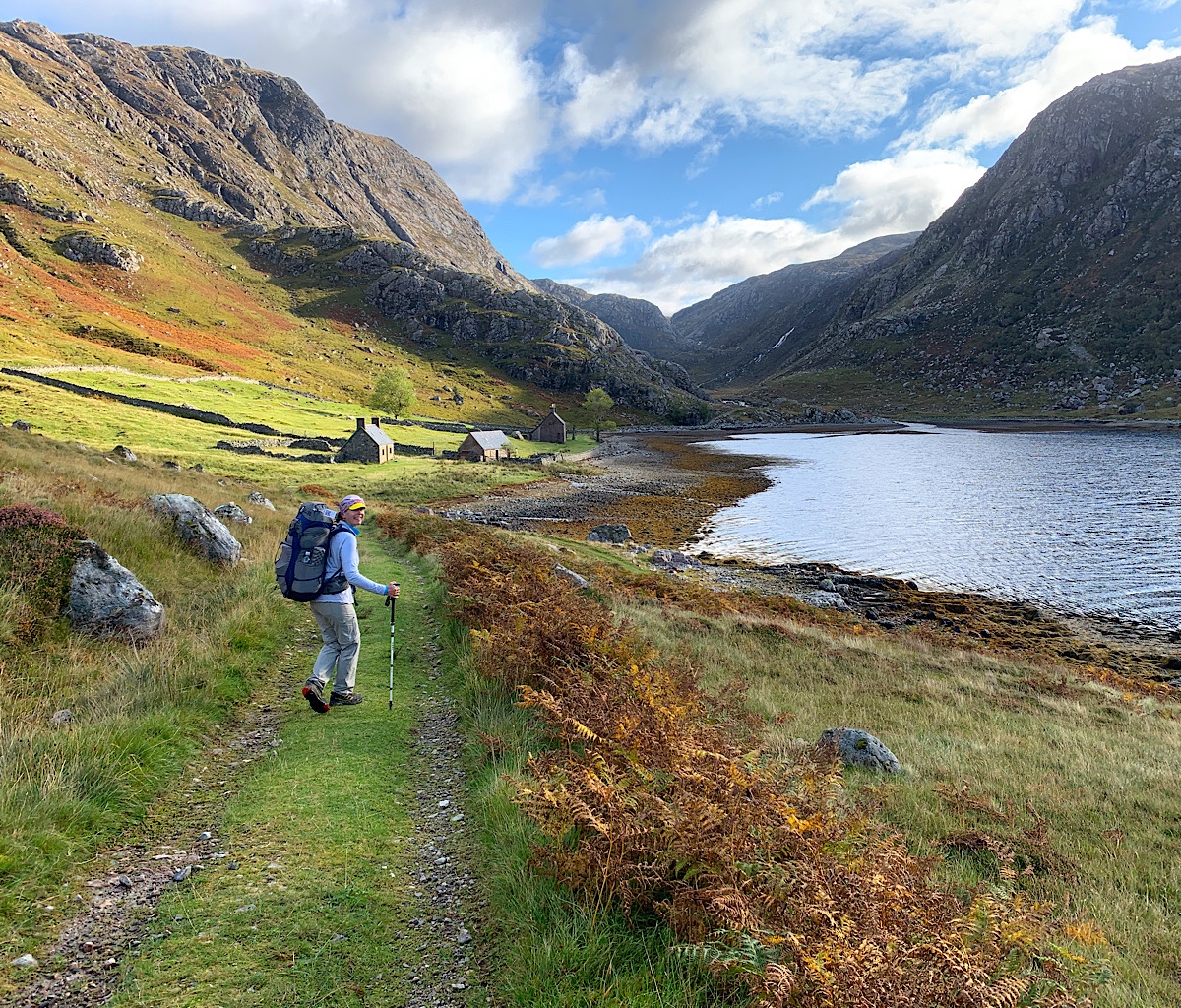
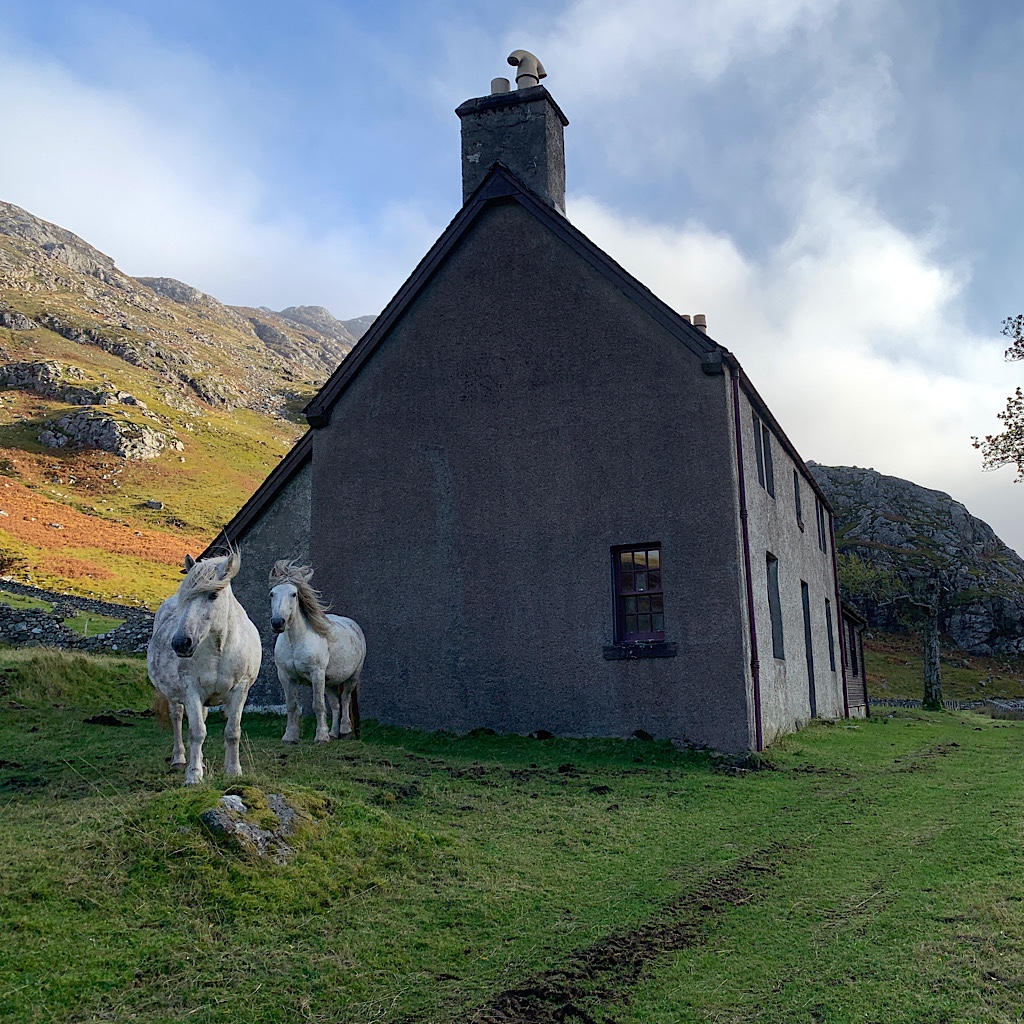
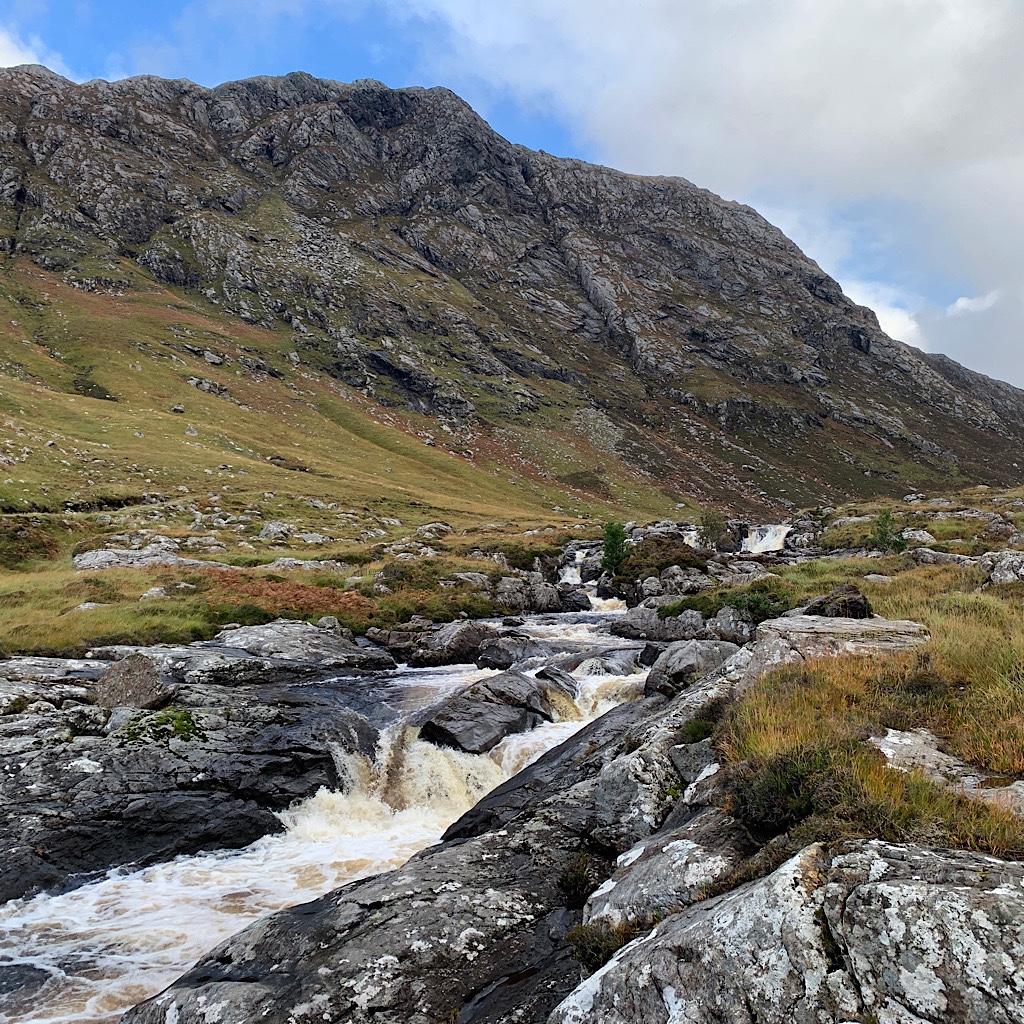
The bothy is unlocked and carries the circular Mountain Bothy Association sign on the front door. We pop in and check out the two main rooms below, one with a fireplace and two above, just wooden floors with large skylights.
It’s so early in the day – and such a fine one – we decide to eat a few bar then press on towards the more remote bothy. It’s funny how comfortable one can get with the weather. Clear, dry and warm until suddenly it’s not.
Like a joke, a massive cloud builds, swirling in a fuzziness directly where we’re headed. I drop my pack and get out the waterproofs. Clear skies are evidently not meant for the entire day.
And we still have the bridge to locate. Well, this bothy is here, it’s open and there’s plenty of space should we turn around, so we head on all suited up now towards the burn. And there it is! Not only a superbly built bridge, but one reinforced with steel.
This one’s not going anywhere.
So even if it rains all night, we’ll have a path back. Funny though, the trail almost immediately disappears as we leave the bridge. It become a boggy, rocky, bracken-choked mess, with the actual ‘way’ anyone’s guess.
I mean, we were warned. But will it be this messy all the way up and over that head?
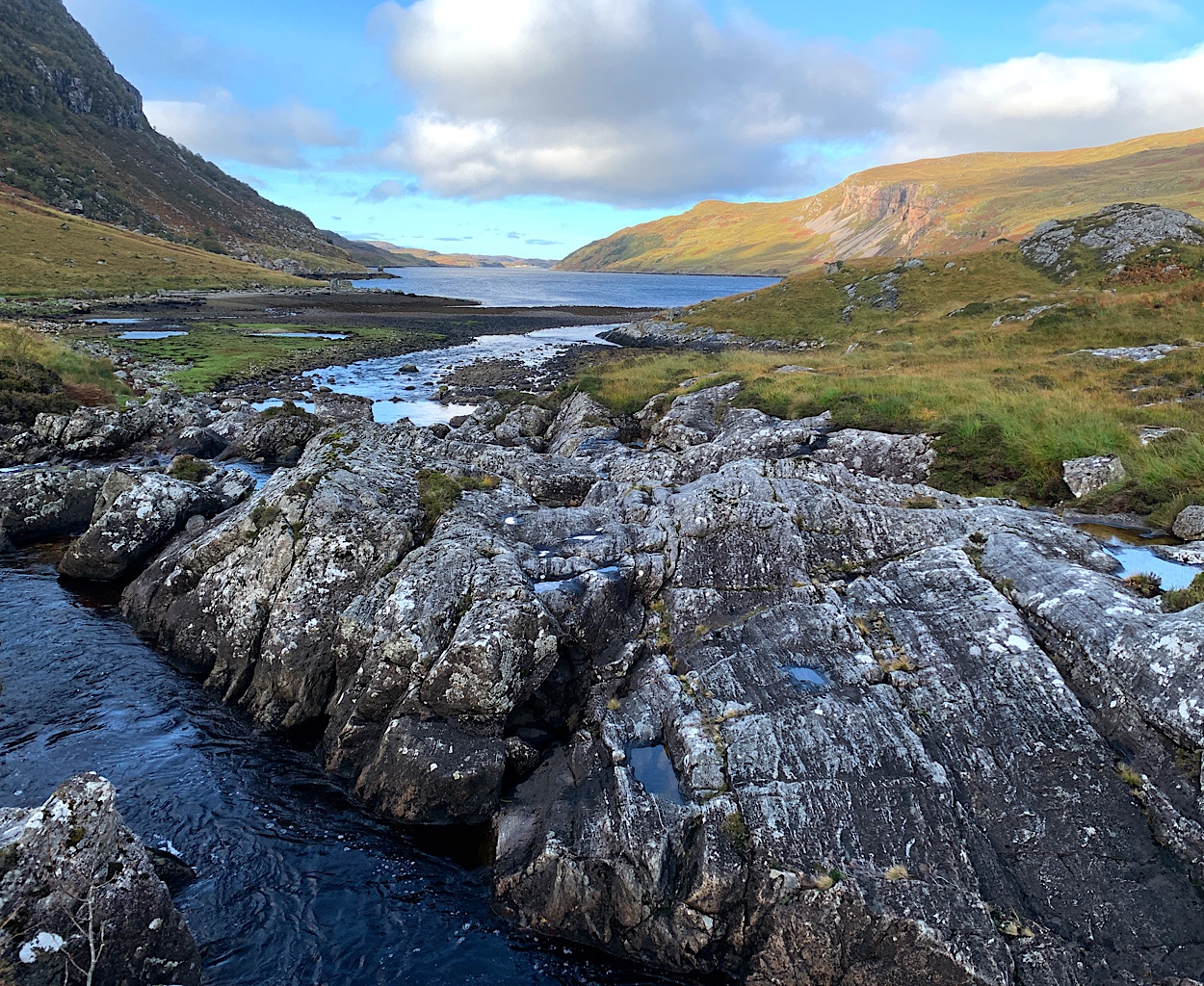
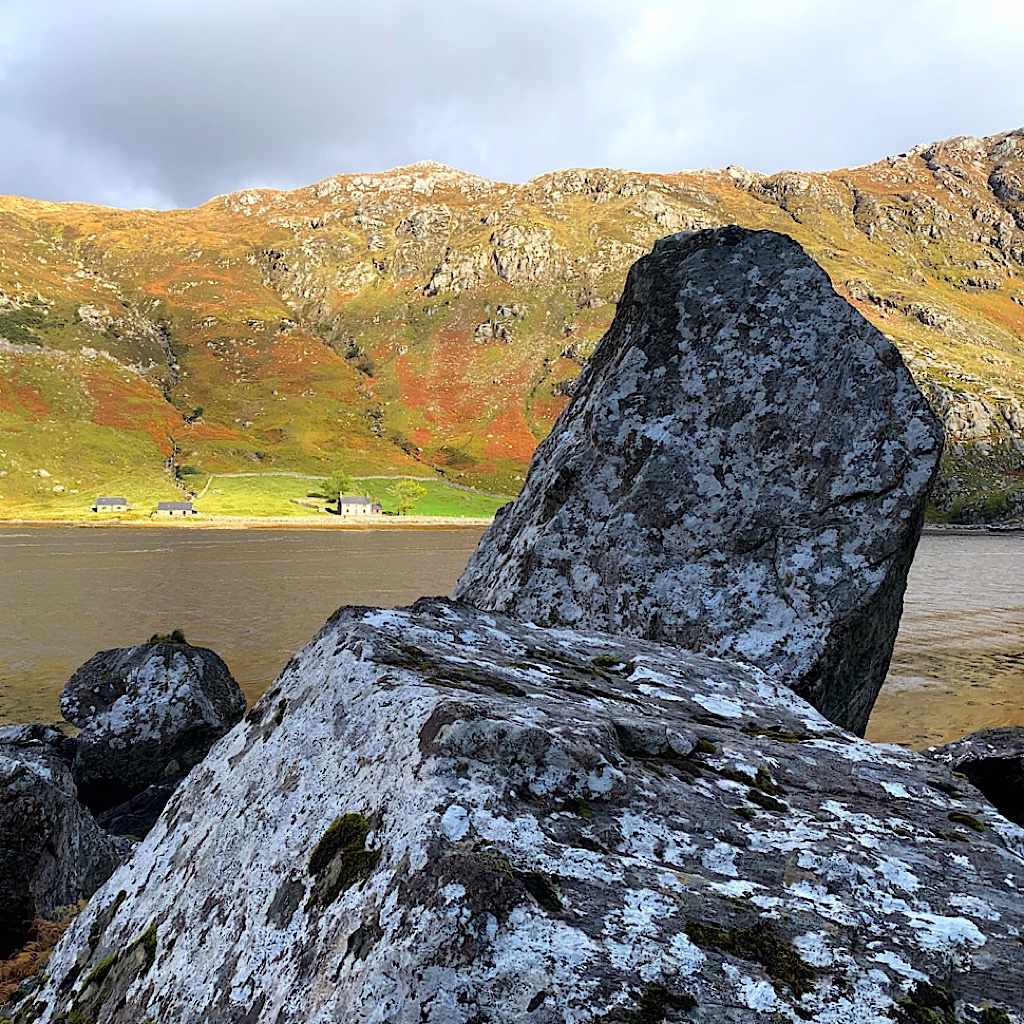
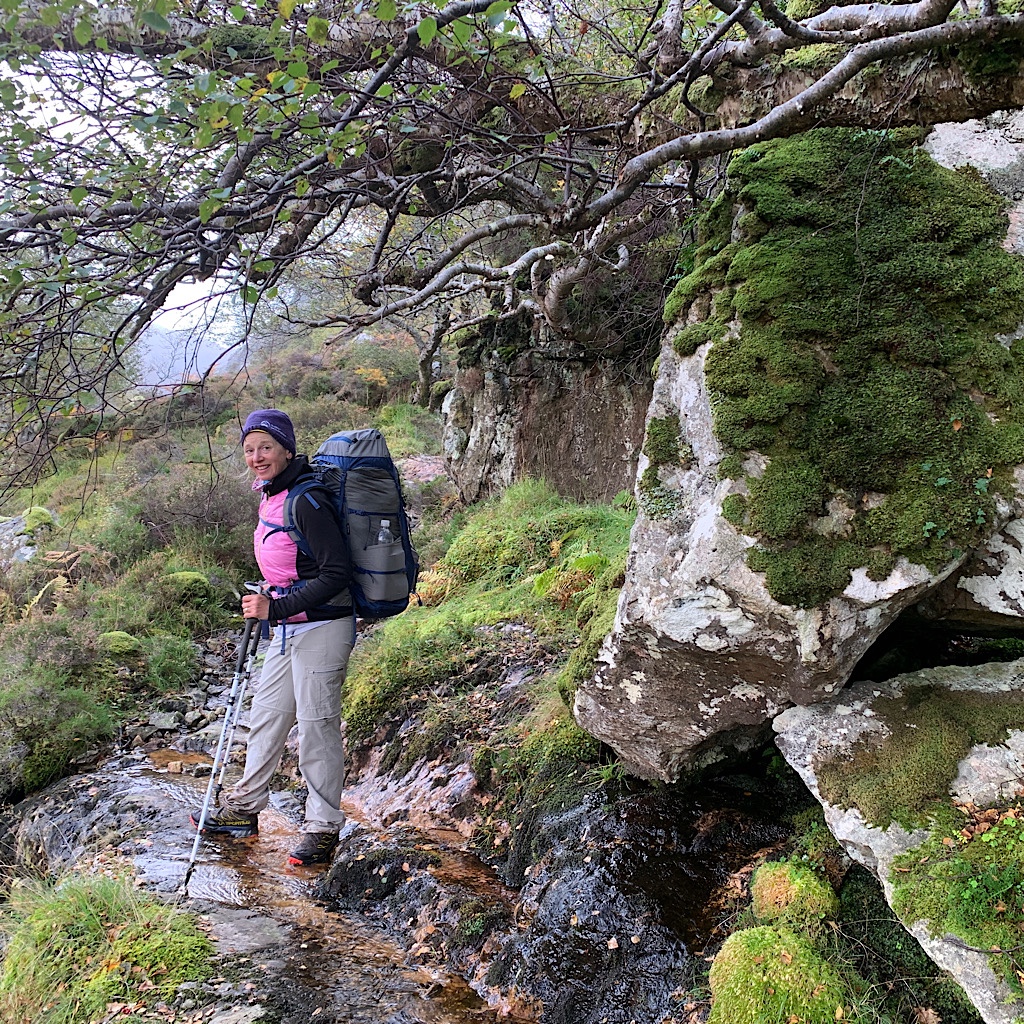
We find an trail – what Ted would call a ‘footpath’ and me, a ‘herd trail’ – but it peters out to a choice: up into boulders and bracken or down into boulders and seaweed.
When moving forward, I’ve found we tend to keep moving. You know, that whole objects in motion tend to stay in motion. It’s not a useful principle when hiking, however, especially when there’s no sanctioned path.
Ted hurtles himself into the bracken following the indentation in the grass. But with rocks underfoot, running water and hidden holes, it’s a leg fracture waiting to happen. We stop to check the map and are spot on. Again I wonder if this be the state of the trail the entire way.
We continue pushing through, grabbing rock and wedging feet into odd positions. Should we turn back? I point to a rock above which appears somewhat separate from the boulder field and suggest we aim to it. When we finally reach it, Ted points back at a perfectly clear path by the loch.
Whoops!
From here, it’s obvious track on rock, some long, slippery slabs with water pouring down in fanciful falls. We reach a riparian area filled with gnarled birch and mosses. I step carefully to avoid slipping on any slimy bits.
The mist hits us with drizzle as we contour around a cliff and out onto muddy grass. The view opens back towards the houses we left this morning and the Atlantic beyond. Just when I’m sure the trail has hit the top, it goes on, climbing and climbing through mud and bog. Ted wipes out here, but falls on his arm and is not hurt too badly.
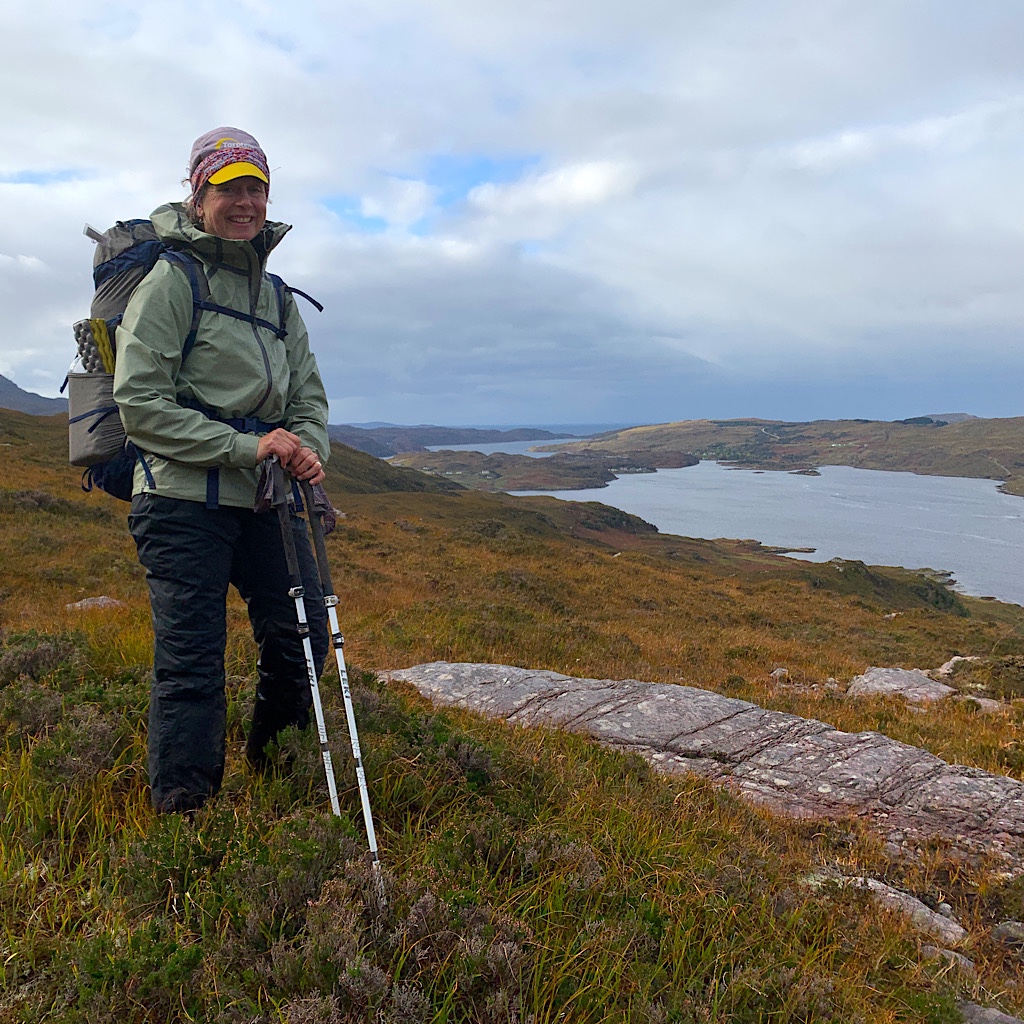
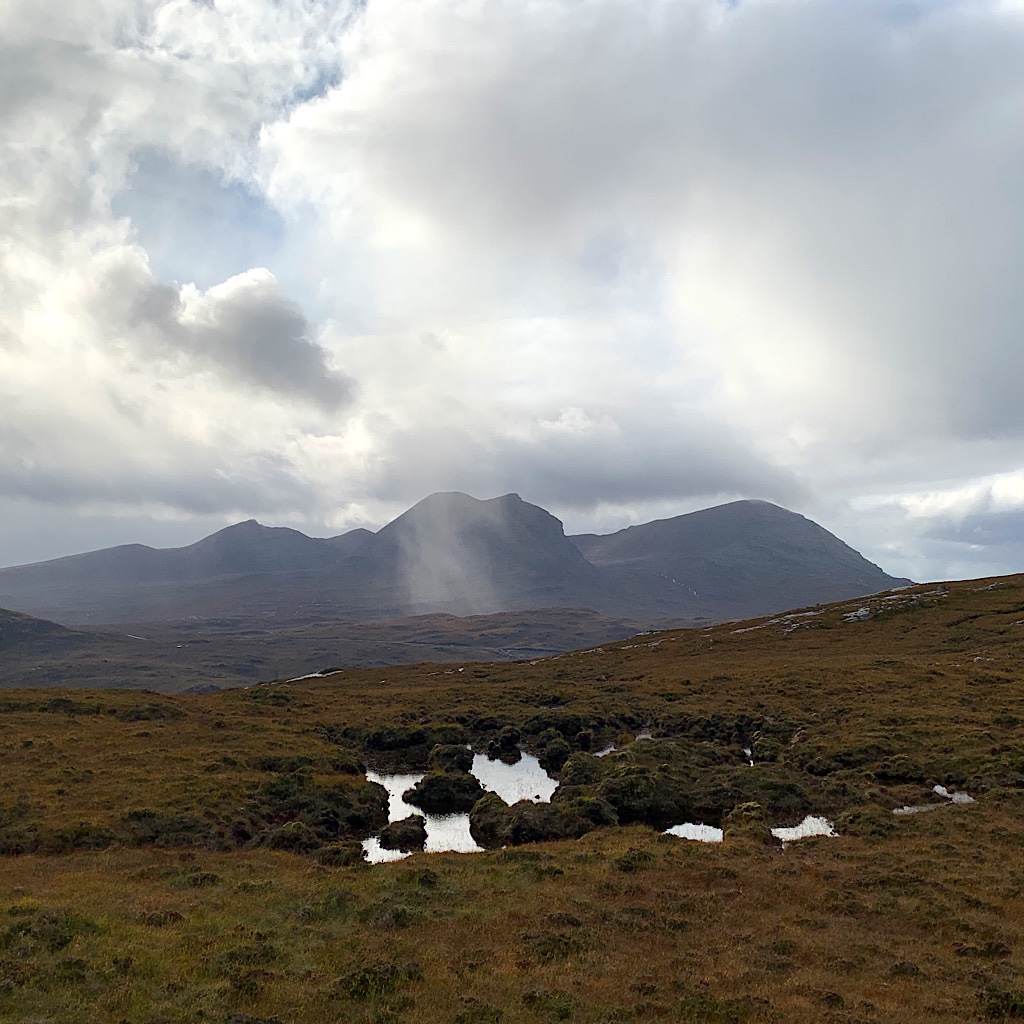
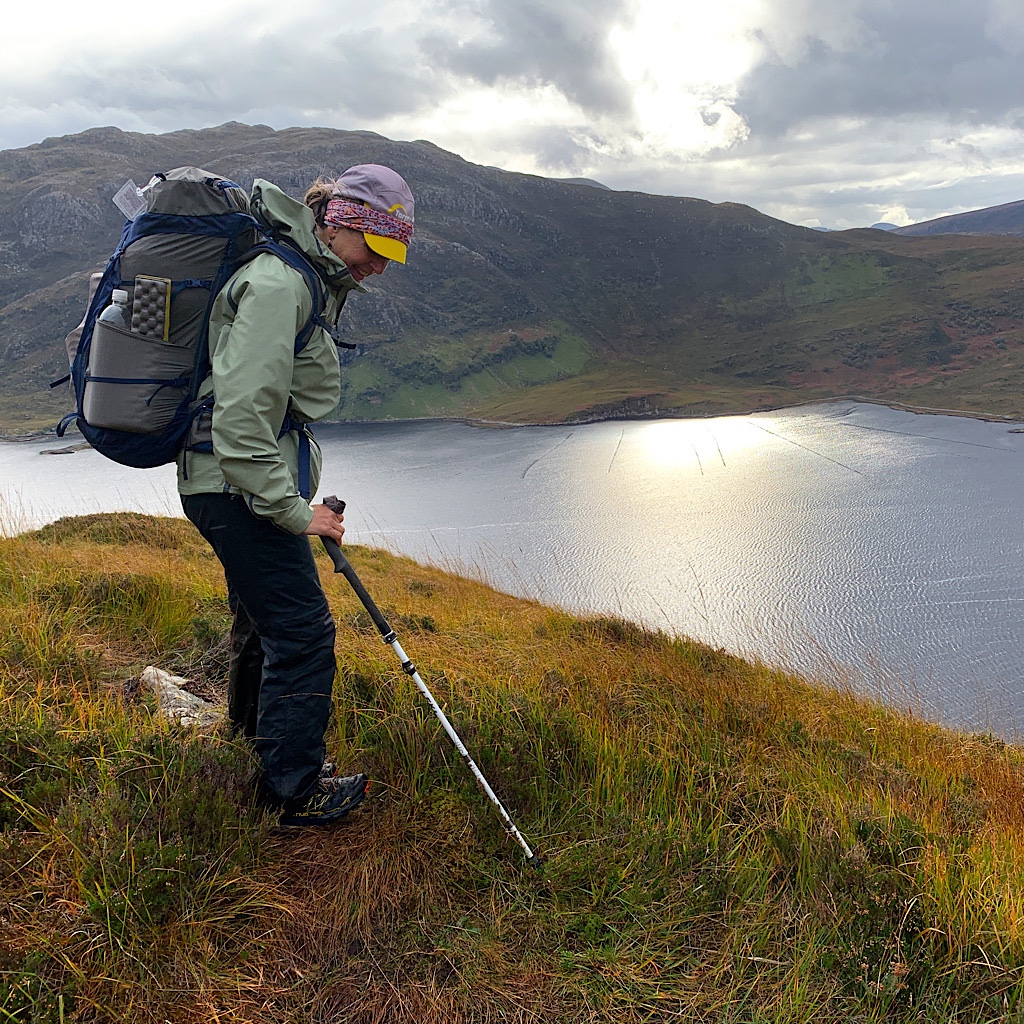
It feels an eternity before we crest the top and see Loch Glencoul below. It’s not actually a different lake but more another arm of the fjord. We’re high above and stay here for a long time, skirting cliffs below and heading in. Just as it feels we ought to go down, we head up again.
But it’s short-lived and takes us to the most spectacular sight of the day: the end of the loch in a U-shaped valley of rounded mountains and massive waterfalls. Numerous islands sprout up from a gently curving peninsula with a long, rocky beach and nestled within is our bothy.
It’s a long way down and unclear how we get there, but we soon hit a track. Alongside is a fence placed there to protect the replanting of native trees from hungry deer, which we hear loudly roaring somewhere in the hills.
The track is incredibly steep and reinforced at each turn with massive stones. My shoes fit well, so my toes aren’t banging into the front of them, but I definitely feel my shins working to keep me upright.
This steep on zig-zags and we’re there within minutes, a beautiful, strong bridge in place for the river crossing. There’s a large storage shed with a new, metal roof on one section, as well as rock walls closing in animal pens.
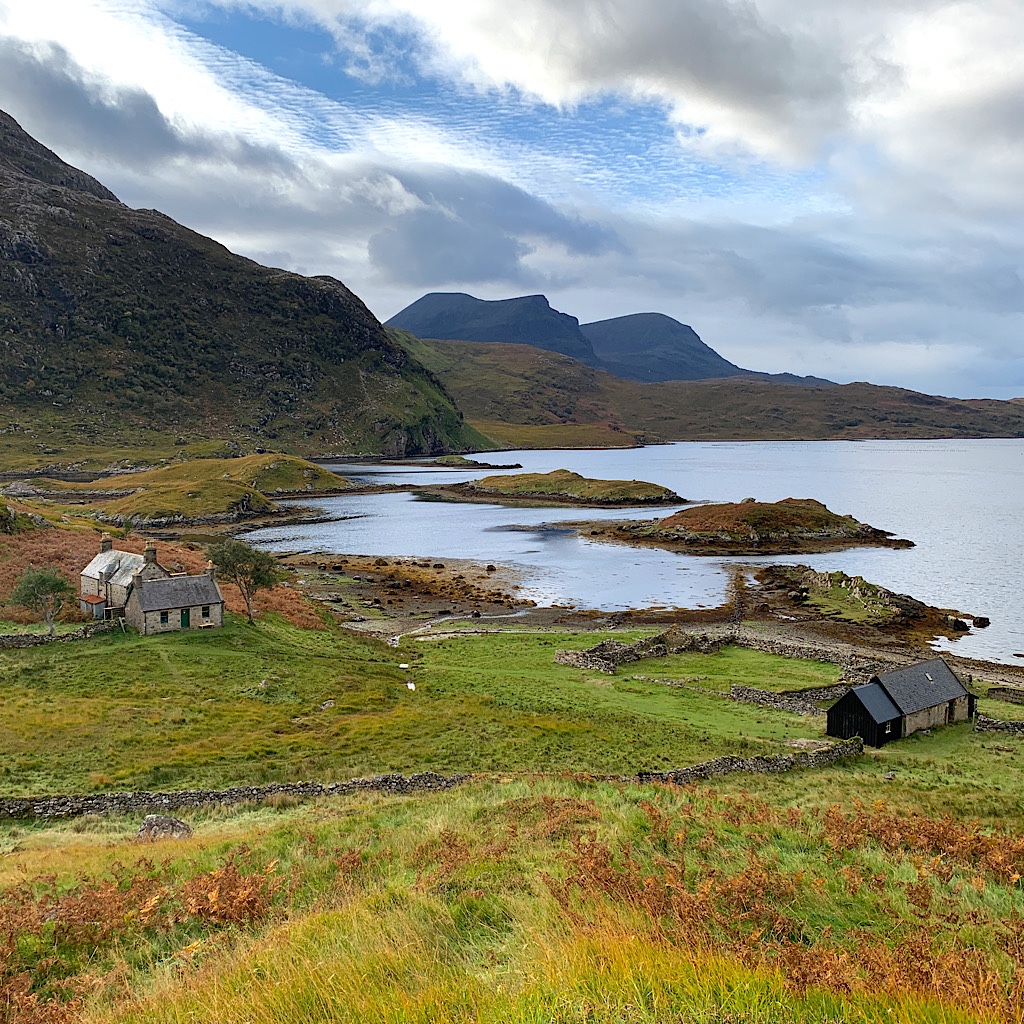
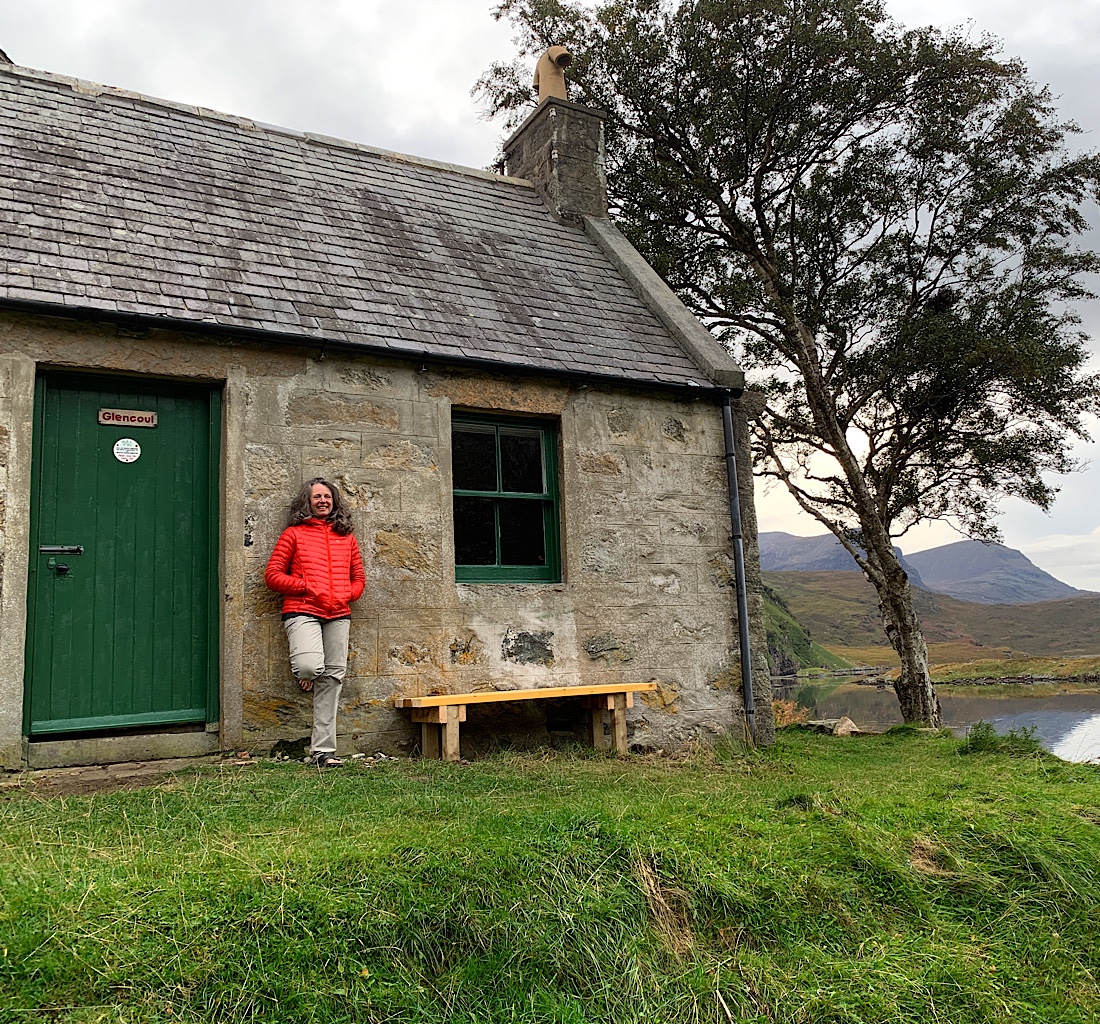
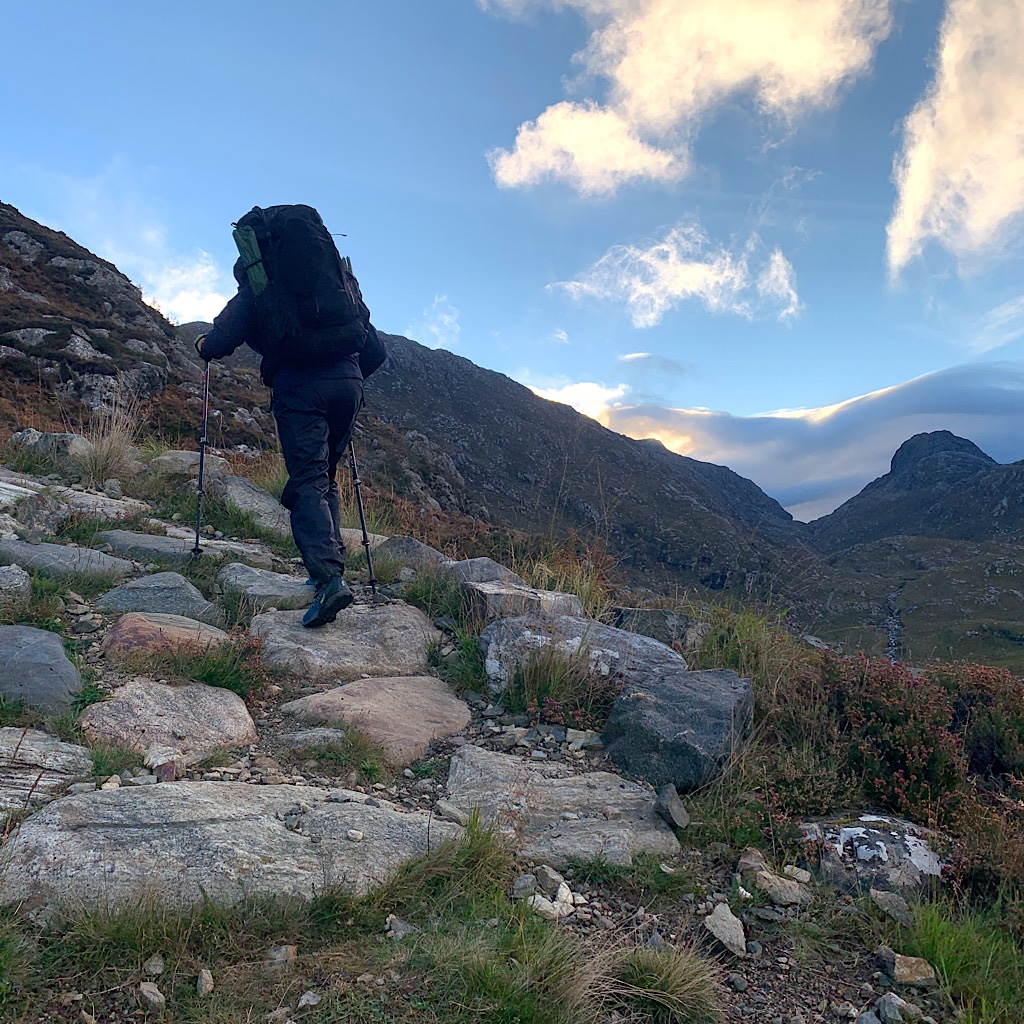
The bothy itself is part of a house that’s mostly derelict. Only two rooms are set aside for public use, bit they’re beautifully appointed, one with a huge wooden sleeping platform that could accommodate about six hikers.
We snag space for ourselves and begin the business of starting dinner. Ted sits down to get out of his wet shoes and socks and I surprise him with a mug full of whisky – yes, I carried it all the way here and it went down smooth!
It’s not long before it goes dark bit thankfully, the bothy caretaker left candles so we sit up for a bit just as a hiker arrives. Alberto is Spanish but living in England. He’s young and fit, and we wonder if maybe we could have kept going through the hard parts, but decide one flooded river crossing was enough for this hike.
He leaves in the morning, not especially early or in an especially big rush. It’s dry but overcast and we decide to stay and make it s day at this magical place. Breakfast is outside sitting on the orange folding chairs outside.
Just as I wonder if we might have more visitors, a man drives up in an eight-wheeled vehicle. It moves a bit like a tank, or maybe more like a centipede, each wheel able to grab the rock and rough trail as it moves.
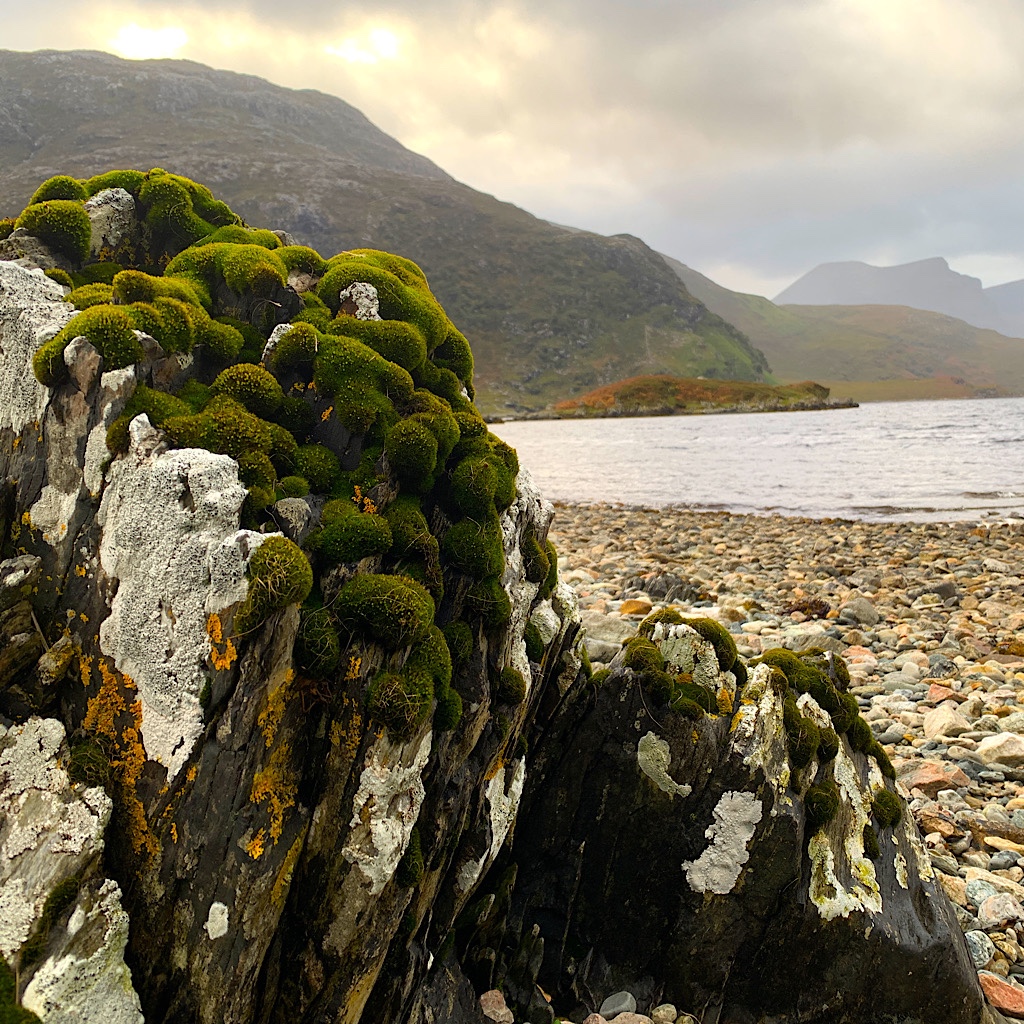
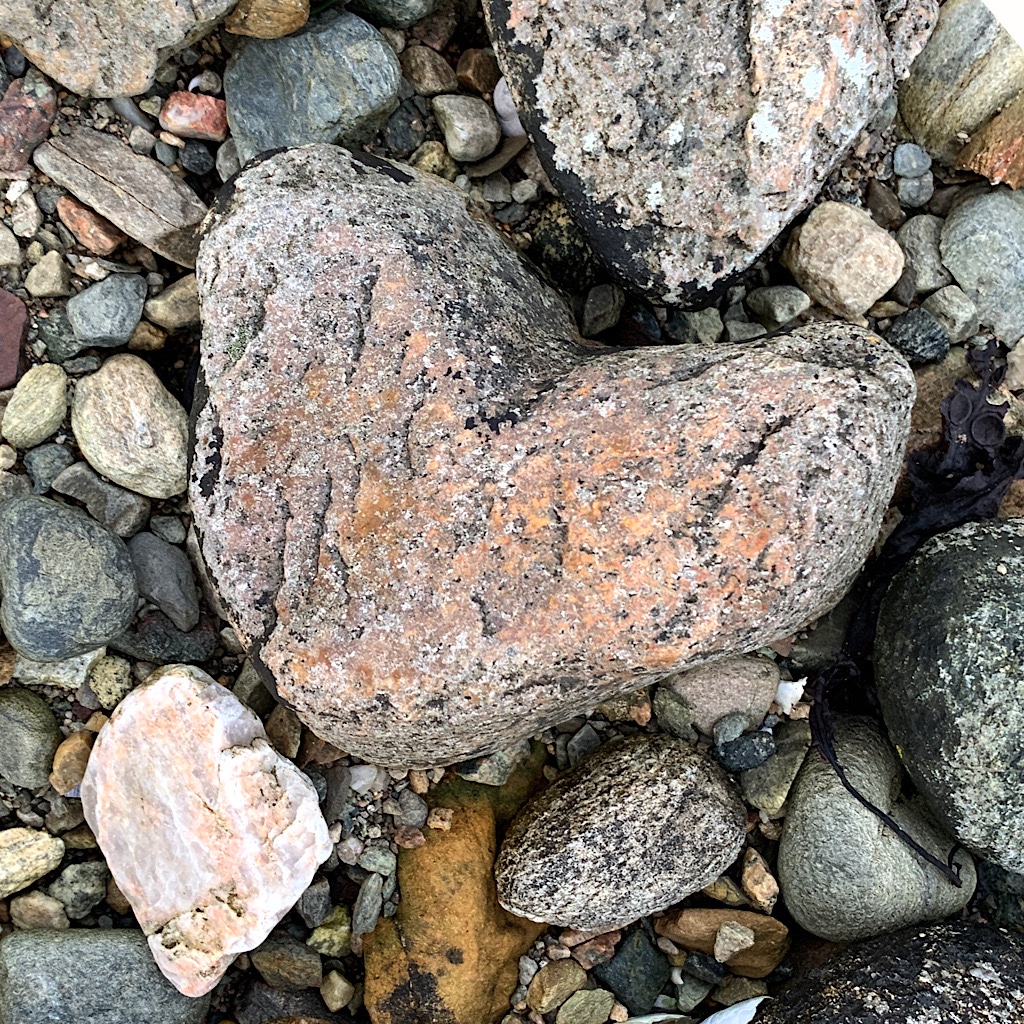
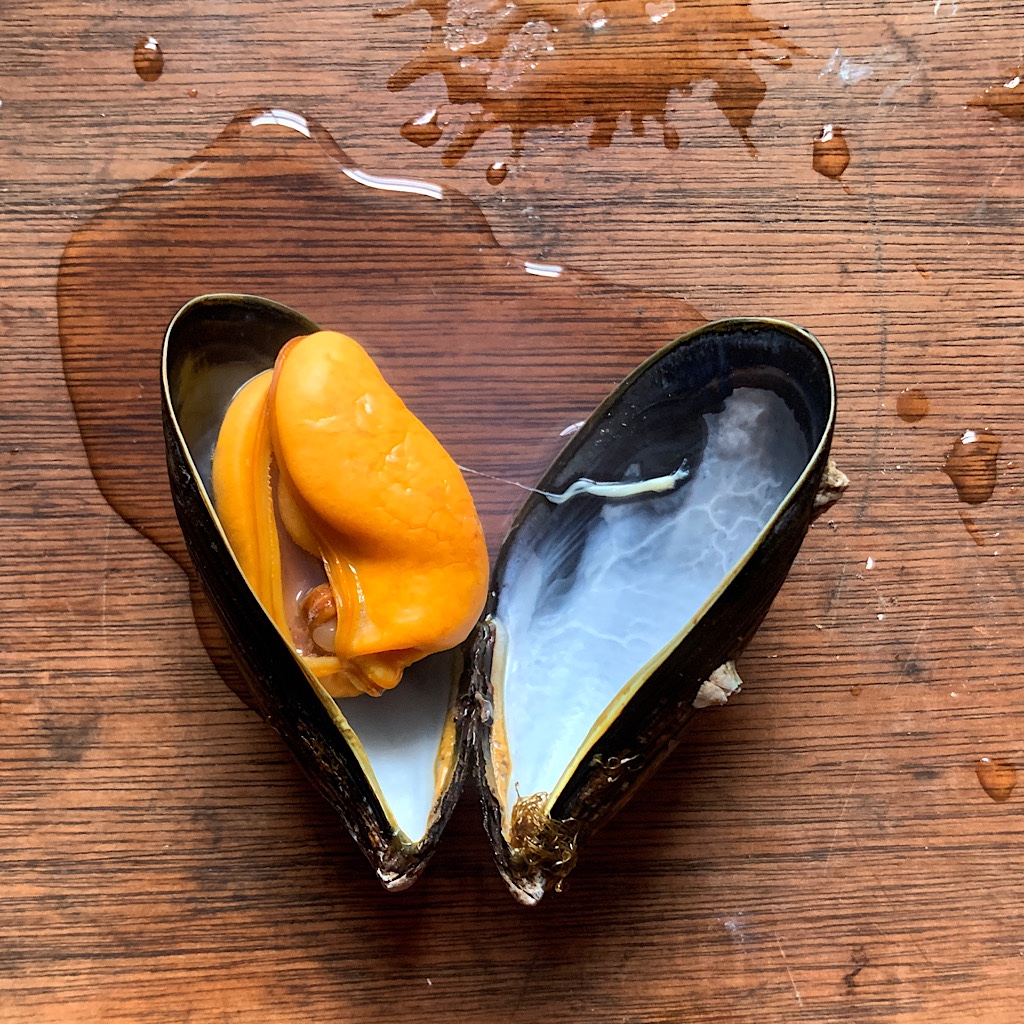
He locks it in the shed then marches our way. Dressed in camo, he carries a gas can on a walking stick over his shoulder. I assume he’ll stay with us and say, “hiya!” His name is Matt and he works as a stalker for the estate, one owned by the Duke of Westminster. So that’s why he’s wearing tweeds and a tie under the fatigues.
And yes, it gets hot being all dressed up. But not now in all this unusually heavy rain. We’re actually happy to hear that wondering if it’s just our wimpy selves unable to manage Scottish weather.
One bit of advice he leaves with us is where to harvest mussels – where he’s walking now, on the rocks beyond the peninsula where the Duke has his private pier.
Of course I suit up, grab a pail and head over. It’s less a pier and more a rock ramp at a cove. At first, I see nothing at all, just seaweed in clumps along large, dark boulders. It’s spongy under my feet as I carefully step on it, reaching the cold water which falls deep quickly.
I spy tightly closed black shells with a tiny bit of blue just above the water. Bug they’re on a rock slightly out of reach. I squish around on the seaweed peering under any rock within reach, and I find one.
It only requires stepping carefully in up to my ankles to lift the heavy seaweed and pluck off several huge shells. They make a lovely plunk in my bucket as I drop them in – 1, 2, 3…27, 28… yes, 28 should do.
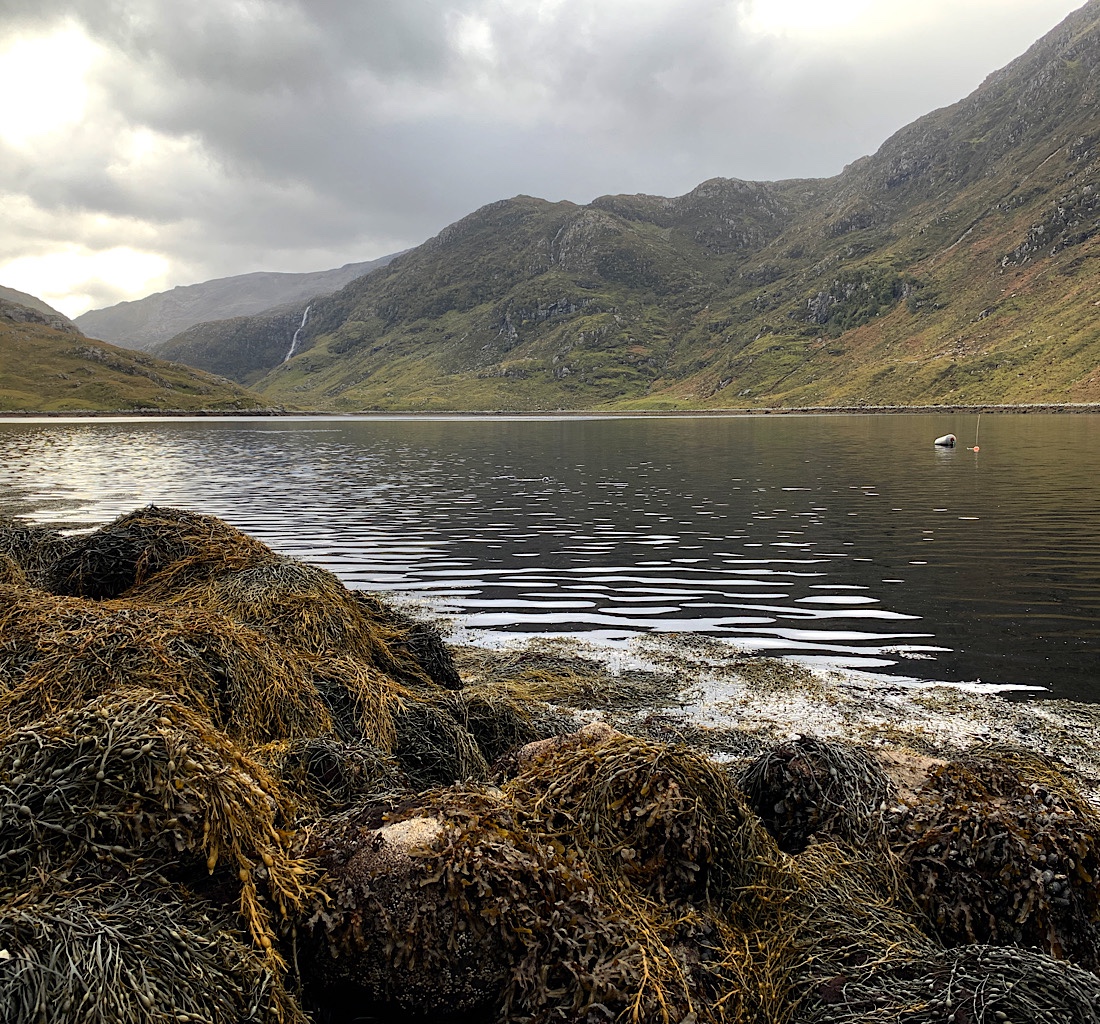
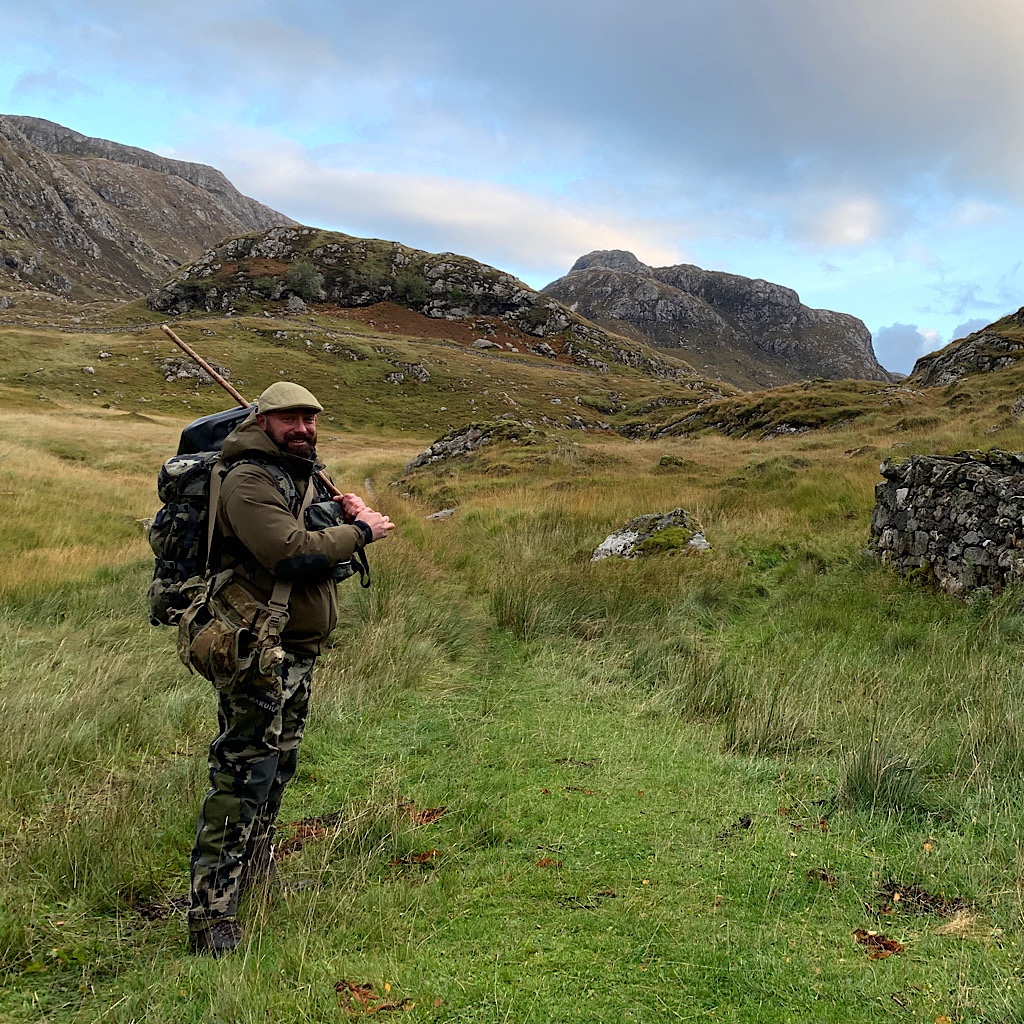
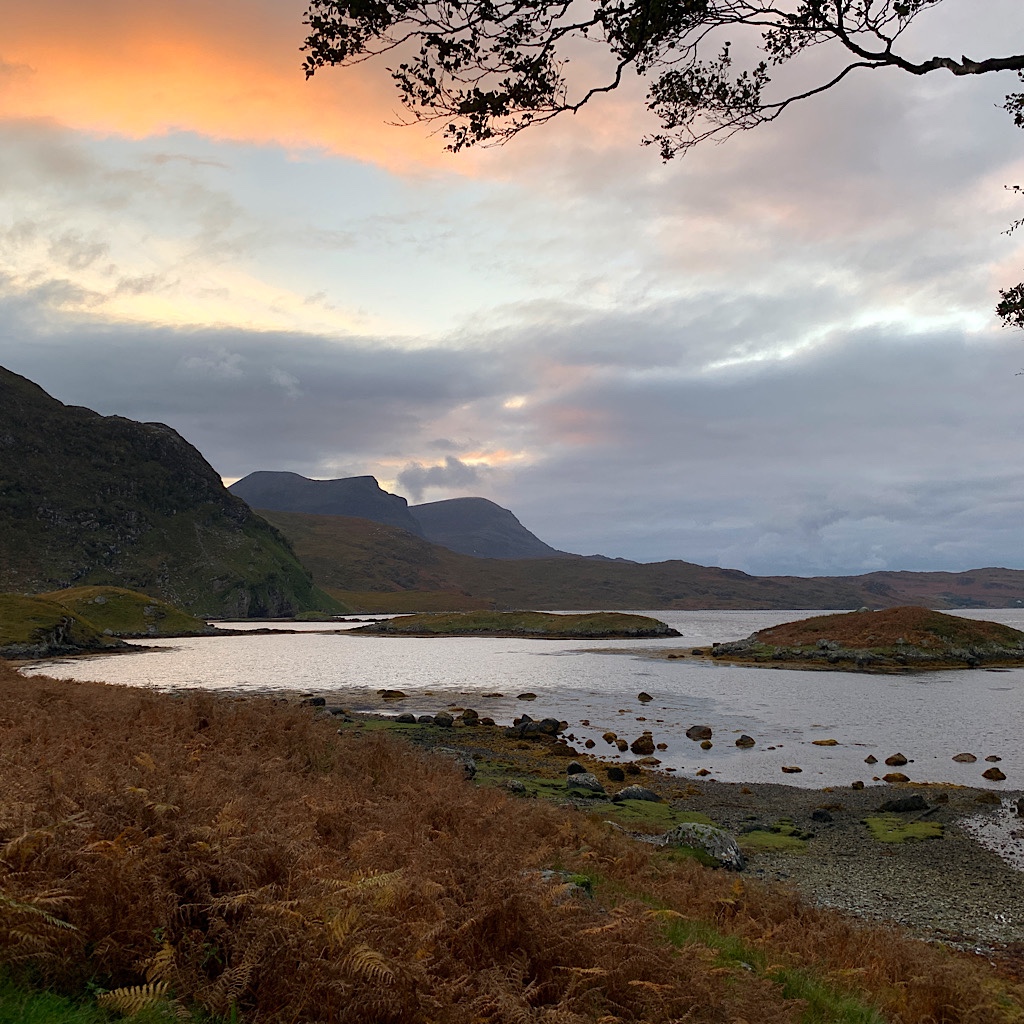
Just as I get ready to head back, I hear a massive splash. A whale? Nessie?!? I stand still and wait and soon a head appears. The water is stirred up and I wonder if it’s just my imagination as whatever it was pops back in the water.
But then it reappears, this time with a friend. They move ever so slowly towards me, stopping and peering. To get a better look, the heads pop up out of the water, white faces with black eyes and snouts.
I smile, and back in they go, splashing hard. Seals, three seals just having fun in this wondrous cove.
Soon, there are three, swimming along and stopping for a look. One proves the bravest and comes very close, as far in as the seaweed. He drops under without a sound, appearing only a few feet away to look at me, his mouth opening in a kind of “hi.”
A blue heron flies past and I see a black cormorant drying his wings on a rock. They appear in consort, distracting me as two otters quickly dart from one side to the next, their lithe bodies glossy in this dour light.
Finally I go, ready for lunch. I wash my mussels in the stream to pull of any scum, then boil them in batches of 7 or so in the Jet-boil. Never has there been a better meal.
Later, Ted and I climb the small hill next to the bothy where a stone cross has been placed in memory of two brothers lost in the great war, aged 24 and 25. What grief their family must have felt.
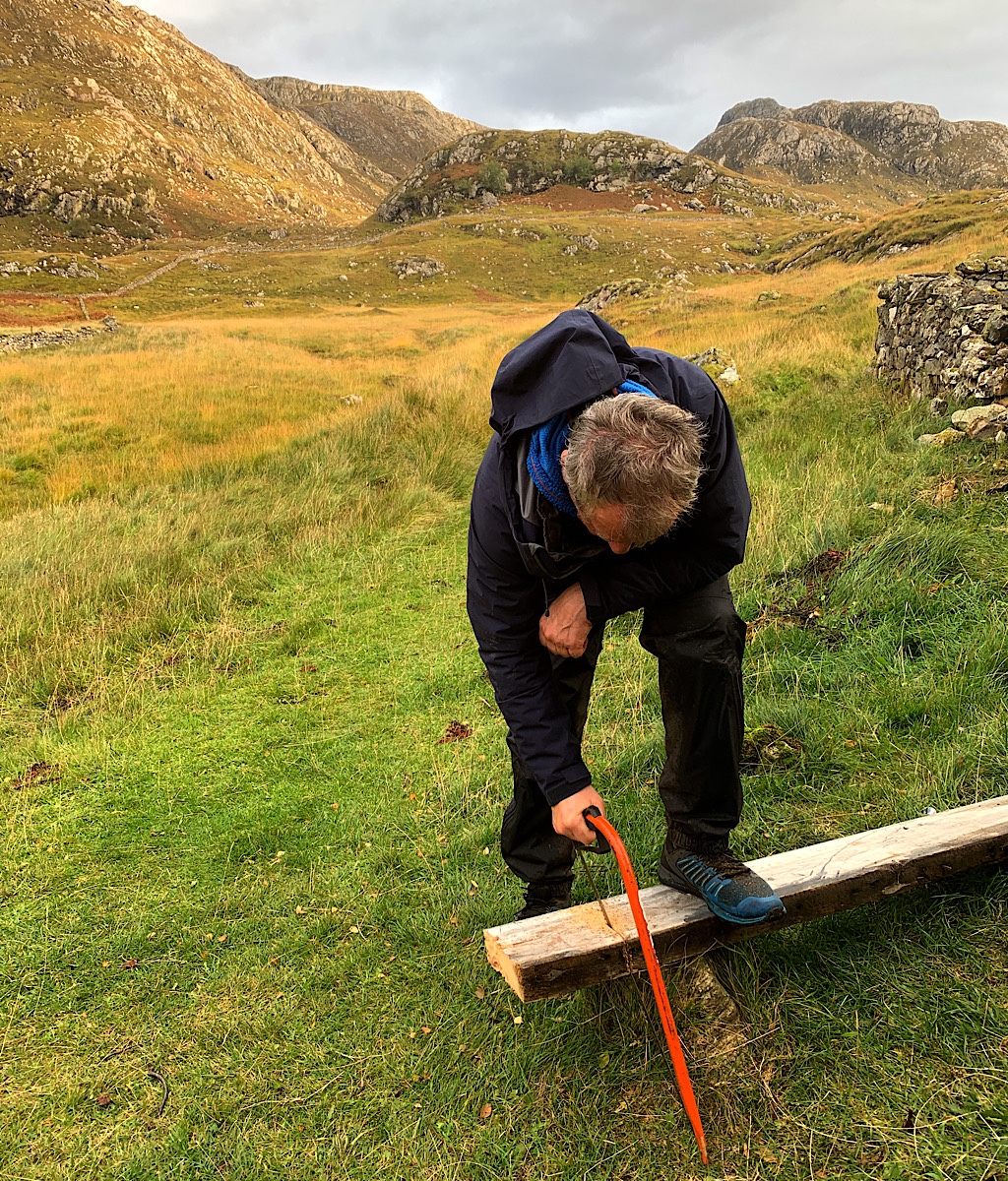
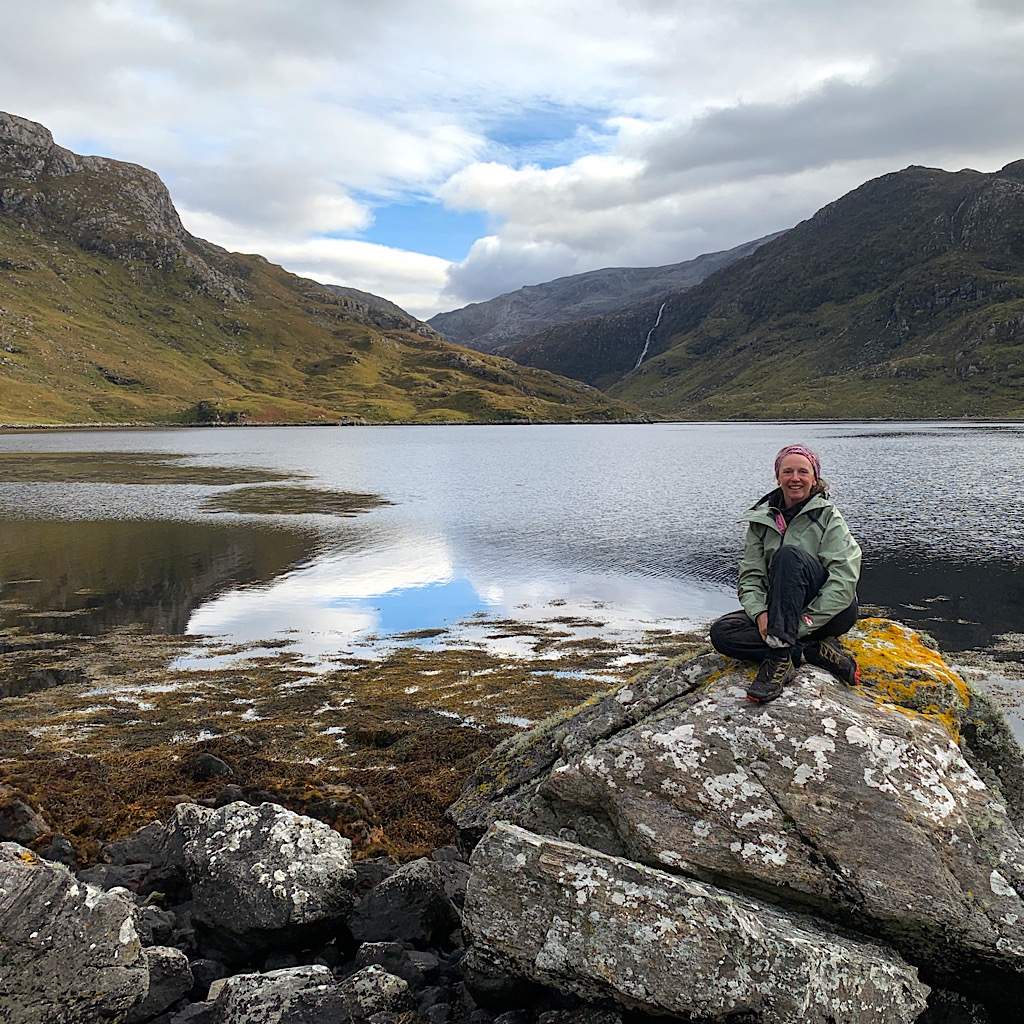
We sit outside as the day comes to an end and it begins to get cold. You know I saw that fireplace in the bothy but somehow never considered using it. I give Ted some pointers and he soon sets one roaring, making the room toasty warm.
It must be all the years of thru-hiking when I’d never consider building a fire late at night that makes this whole experience feel giddy and new. But bothy protocol is to never take more wood then you use, so I head outside to see what I can find.
Twigs, damp twigs and damper twigs. I take them inside to dry next to what we built when Ted calls me around the corner. “Ali, what do you think?” He’s found an old useless and wet plank dumped out here from the derelict side of the house. I knew there was a reason for those saws hanging inside!
Ted does most of the sawing, creating pieces small enough for the tiny space. Without an ax, they’re bulky, but slowly they dry and begin to light. I take a shot at it too, and make him laugh with my willful nature, never giving up as I grunt and cut.
There are a few odds and ends in the wood box – a broom bristle, cracker boxes, one mitten – and they’re all chucked in, making a gorgeous light and warming us up. In the end, we create bright red coals but still leave behind pieces for the next visitor.
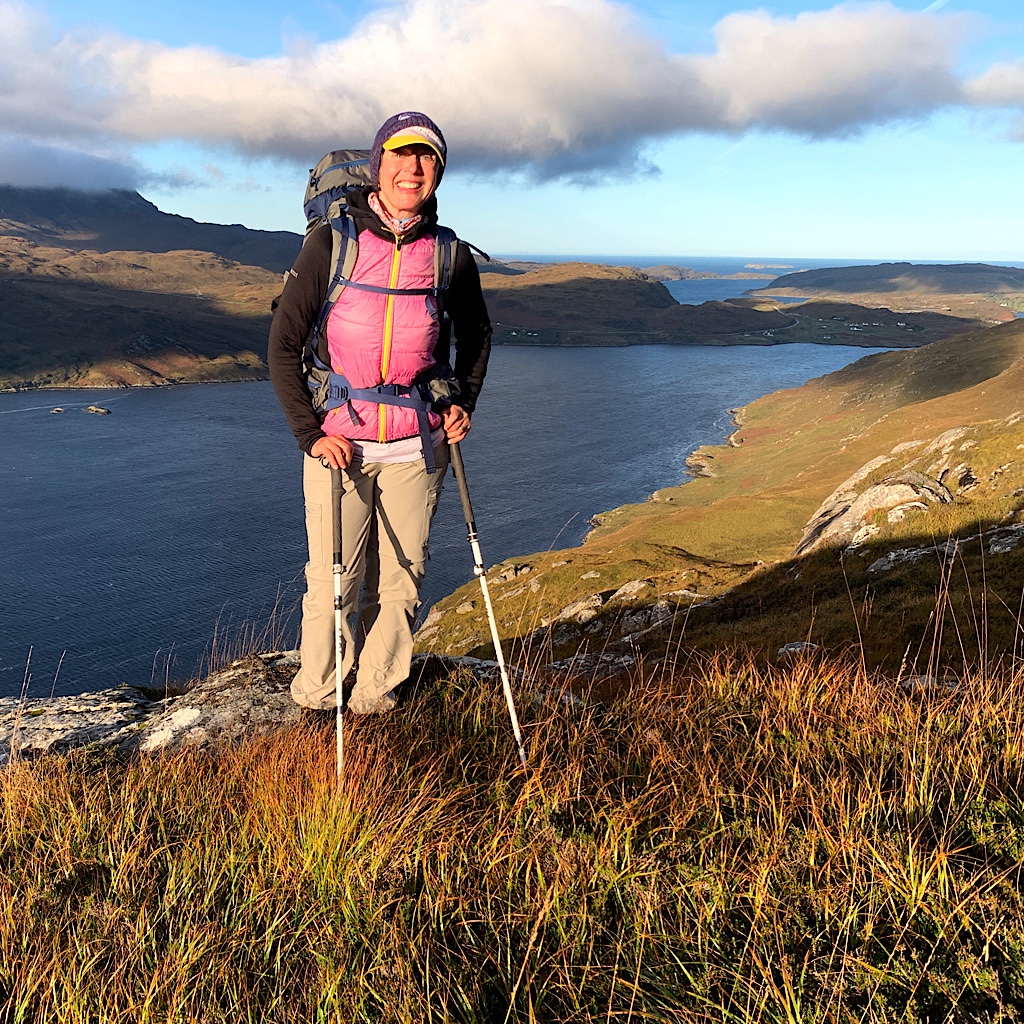
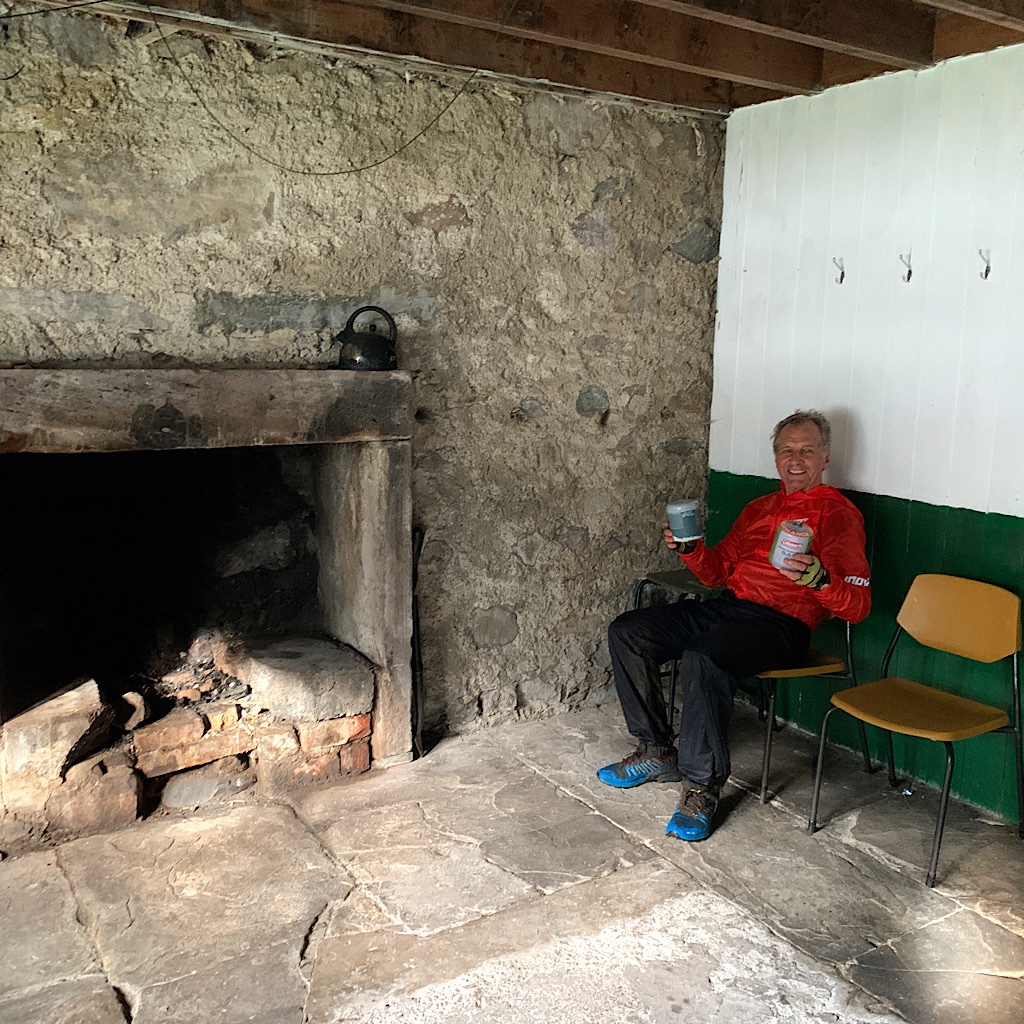
It’s a cold night under crystal clear skies, the mist laying like puffs of cotton candy on the distant peaks. We earned it, but have to bundle up for the walk back, easier and still lovely. Our plan is to drive north and walk the two days/one bothy to Cape Wrath. But just as we heat up water for coffee, we notice our camp stove gas is nearly out. Does this mean a side-trip all the way back to Ullapool?
It’s steeply up, then slippery down the five miles back to the bridge. I’m pondering our dilemma the entire way because the weather threatens to change again from mostly dry to mostly soaked-to-the-skin wet. I don’t want to delay on this last bit.
As we approach Glenhue, I wonder if maybe someone left behind their unused gas as many people do. It becomes a bit of an obsession as this time I take the lead on the hardest bits of bog and clag, trying not to fall while barreling down through rock, bracken and waterfalls-as-trail.
We make it in one piece, Ted – the expert at downhill – commenting on my good pace. I bang first into the bothy, looking in both rooms, then climbing the steep stairs.
Nothing.
It’s Ted who finds the tiny room in the back, a kind of storage area where not one, but two, canisters sit awaiting our greedy hands.
We’re saved! We sit to have a bar before the long walk on track back to the car. I learn from this that one should always snag leftover gas if intending to move forward, because you just never know.
I also think it’s a good idea to see what else might be laying around for our use on these final days. A can of anchovies, one packet of dried soup, a deflated bag of wine – with some still in it!
11:00 am on a Sunday morning and there’s something to toast – a fabulous few days at the bothy, and enough cooking gas to continue. Yay!


2 Responses
Alison, I’m there with. What larks!
amazing hike in spite of so much rain!!!